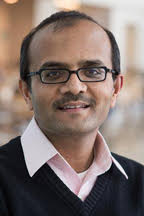Dr. Vaishnav is a socio-technologist, an engineer trained to understand human as well as technological complexity in large systems. His research is presently focused on building an information architecture in sectors like agriculture, water, and data-driven urban governance to reduce the information poverty. His experience ranges from building Internet and telecom technologies at Bell Labs to designing systems of technology and policy interventions in the developing world.
He teaches technology, design and entrepreneurship at MIT’s Sloan School of Management, and is the Academic Director as well as a member of the founding team of the MIT Tata Center for Technology + Design. He is also the Sunderrajan Chair Professor at the Indian Institute of Science, Bangalore. He also advises several governments, start-ups, and NGOs. He holds a Bachelors and Masters in Electrical and Computer Engineering, and an MS and PhD in Technology, Policy and Management from MIT.
Can you tell us the focus of your work at the Tata Center?
I am a Senior Lecturer in MIT's Sloan School of Management, and serve as the Academic Director of MIT Tata Center for Technology and Design. My work focuses on identifying large information gaps confronting resource-poor communities, and building socio-technical solutions to bridge such gaps. I have so far focused on addressing challenges in agriculture, water, urban governance, mobility, and health. The long-term question that motivates my research and therefore drives the selection of shorter-term projects within it is this: How can we avoid the gross inequality, which we have come to endure in the material world, in the information world?
You have created a very interesting video in Hindi to understand the dynamics and challenge of the Coronovirus in India,
What motivated you to create this video and share it?
Two aspects motivated me to create this video:
1. It has been well-documented that human brain struggles to understand non-linear phenomena like the one we are facing (e.g., a growth of a virus is exponential). In such situations, it is seen time and again that first we are complacent and then beyond a tipping-point we get panicky. Such models that explain the structure of the problem are helpful in classifying the complexity the presently surrounds us. I have been urging people I know to prepare for this storm since early February, but I have really struggled to convince them about its scale and scope. I still think most people still don’t grasp its gravity fully. Thus, as I am trained to create such models, I am doing my bit to help people make sense of things.
2. I work with a large number of civil society organizations in India, where I have many collaborators who are scientifically trained but are more comfortable in operating in their own languages. If I were to hazard a guess: I’d say only about 10% Indians may prefer operating solely in english. Most others prefer Hindi+english—like in the video I have made—or their-mother-tongue+english. With this video, I wish to strengthen their hand in understanding the “why†behind all of the recommendations they are hearing, so that they can further explain it to the communities they work with, who are even further removed from education in english.
How is this video being used in India?
It’s early to say. There is an effort to translate an abridged version to seven other Indian languages. Collectively, these translations are expected to make this material accessible to 90% of Indians.
What are the special challenges with regards to India as regard Covid?
1. Population density makes the spread easier, as in China.
2. 90% of population works in the unorganized sector (i.e., those who don’t have social security or health insurance through work). In recent years, employment guarantee and health insurance have become available through government schemes, but still the awareness and access is low. So, lack of safety net is a unique and grave challenge in the Indian context.
Is India doing the right things to control the spread?
India has move swiftly and decisively. Given the population, expanse, and diversity, the measures taken are impressive. I hope the society will cooperate to collectively flatten the curve as intended.
What do you think will be the impact of COVID on the informal economy in India which is a huge aspect of India?
The most difficult predicament is that of the urban poor who live in a household where the income sources are not diversified and who have no strong connections to retreat to the rural area. The seasonal migrants from rural-rural or rural-urban areas — totaling to about 120 million Indians — have a mixed bag. On one hand, they have a shelter to go back to in their villages and their farms to feed them (assuming their land is fertile and irrigated), but their urban source of income that produced a financial cushion is likely to be gone for some time. I am still analyzing the net result as the system is changing so dynamically.
What measures should the government take to minimize the economic difficulty?
For the moment, a stimulus package to help with livelihoods and underwrite losses for businesses, especially the small and medium scale, to the extent possible.
Thanks for your time
Thank you

